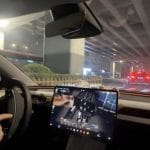Tesla has officially launched Full Self-Driving (FSD) in Mexico, marking another major step in its global expansion.
This is the third international expansion since FSD first debuted in the United States, and it signals a big move toward Tesla’s vision of a fully autonomous future.
Tesla Says “¡Hola México!” as FSD Rolls Out South of the Border
The exciting news was first shared by Tesla Owners Mexico on X, quickly followed by an enthusiastic confirmation from Tesla AI with the simple but powerful message:
“¡Hola México!”
¡Hola México! 🇲🇽 https://t.co/Hidp7vw9qz
— Tesla AI (@Tesla_AI) February 11, 2025
This expansion means that Tesla owners in Mexico can now experience FSD’s advanced autonomous driving features, just like drivers in the U.S. and Canada.
Even more interestingly, the geo-fencing restrictions may now be lifted, allowing U.S. Tesla owners to drive into Mexico and continue using FSD without interruption.
FSD Global Expansion: What’s Next?
Tesla has some big ambitions for FSD expansion in 2025. According to their latest roadmap, here’s what’s coming next:
- Q1 2025: Tesla plans to launch FSD in Europe and China, pending regulatory approval.
- Q2 2025: FSD will expand to right-hand drive (RHD) markets, with timing based on approval processes in each country.
However, not everything is smooth sailing—especially in China.
China’s Regulatory Challenges: Why FSD Might Face Delays
China has some of the strictest data privacy laws in the world, making Tesla’s FSD rollout there particularly tricky.
Key Roadblocks in China:
- Data localization laws prevent Tesla from using its U.S.-based AI training centers. All training data must be collected and stored within China, meaning Tesla needs to build local infrastructure before launching FSD.
- Tesla’s fleet data advantage is limited. Unlike in the U.S., where Tesla gathers massive amounts of driving data from thousands of vehicles, China’s rules restrict data-sharing, making it harder for Tesla to fine-tune FSD based on real-world driving patterns.
Because of these obstacles, FSD in China could take longer than expected, possibly shifting Tesla’s focus to expanding FSD in Europe and Australia first.
A Brief History of Tesla’s FSD Expansion
Tesla’s FSD journey started in the U.S., but it didn’t take long to go global:
- Late 2021: Tesla first introduced FSD Beta to a small group of U.S. users based on a perfect Safety Score of 100.
- March 2022: Tesla expanded to Canada with FSD v10.11.1.
- Later in 2022: FSD rolled out to Puerto Rico.
- Now in 2024: Mexico joins the FSD club as Tesla continues its international expansion.
With each new country, Tesla inches closer to making FSD a true global technology—but regulations remain a major challenge in many parts of the world.
Tesla’s Bigger Vision: Robotaxis & the Future of Autonomous Driving
While FSD expansion is making headlines, Tesla is also gearing up for its biggest autonomy project yet: Robotaxis.
- The first Tesla Robotaxi fleet (nicknamed “Cybercabs”) is set to launch in Austin, Texas, in June.
- These self-driving taxis will likely run on FSD v14 or a specialized version of Unsupervised FSD.
- Tesla is working on cleaning hubs and wireless charging stations to support its upcoming fleet.
The Cybercab project could be a game-changer for Tesla, proving that true autonomy is within reach. If successful, it could pave the way for FSD expansion into more cities and countries worldwide.



